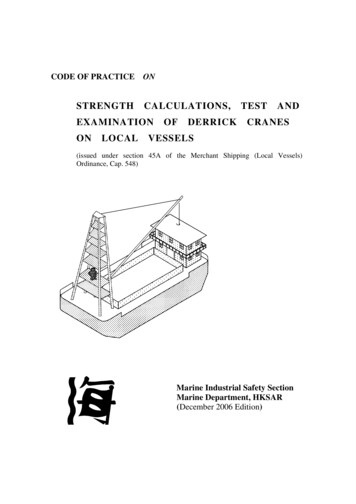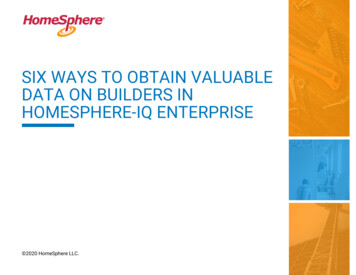
Transcription
gasnetworks.ieGuidelines forDesigners and Builders –Domestic SitesPage 1 of 13
Guidelines for Designers and Builders - Domestic SitesContents1General Information and Single Occupancy Dwellings1.1Introduction41.2How a Gas Meter is Installed 4General rules41.3Self-Trenching Information5Gas Mains5Gas Connection Pipe (Service Pipe)51.4Excavations Parallel to Walls61.5On Site Requirements61.6Gas Safety on Building Sites 7Do’s and Don’ts on Building Sites71.7Building Line81.8Meter Location9Where to locate your meter9Where not to locate your meter111.9Meter Box Types111.10 Meter Box Dimensions12Surface Mounted Meter Box with Ventilation12Recessed Meter Box with Ventilation131.11 Recessed Meter Box in Pillar Enclosure141.12 Foundation Requirements for Preformed Bend below ground151.13 Meter Box Internals161.14 To-Do list Before a Meter can be Fitted161.15 Wayleave16When is a wayleave required?162Multi – Occupancy Dwellings2.1Multi- Occupancy Dwellings - GeneralMulti-Occupancy DefinitionMulti-Meter DefinitionGeneral Meter RequirementsInstallation up to the Meter2.2Option 1: External Multi – Meter Location2.3Option 2: Internal Multi – Meter Location - Above Ground LevelVariation A: Meters in Common Areas2.4Option 2: Internal Multi–Meter Location - Below Ground LevelVariation B: Underground Car Park or Open BasementType 1: Top Entry Cabinets pre-fabricated off-siteType 2: On- Site Fabricated Meter Manifold.2.5Multi – Meter Compartment TypesPre-Fabricated MetersPurpose Built Meter Compartment2.6Internal Building Dimensions for various Meter Bank clusion & Appendices3.13.23.3Checklist of Essential Information required by Design28Irish Standards29Appendix - Excavations Parallel to Walls 29Page 2
Siteworks Activities ManualMANUAL No. AO/MN/002Rev. 0 Date: February 2015Guidelines for Designersand Builders Domestic Sites1General Informationand Single OccupancyDwellingsPage 3 of 13
Guidelines for Designers and Builders - Domestic SitesSection 1 - General Information and Single Occupancy Dwellings1.1IntroductionThis guide outlines the permitted locations, positions, safe depths and distances the installation of your natural gasmeter and meter box when connecting to the natural gas network.It is designed to give guidelines for designers and builders on development sites with domestic and commercialloads. The preferred location for Gas Networks Ireland (GNI) to locate the gas meter is externally. This is to allowfor ease of meter reading, maintenance and operation assurance. However a meter can be located internally if itis not possible to locate it externally and if the gas is being supplied at a low pressure of 100mbar or less. For moreinformation on locating meters internally please consult the Industrial and Commercial Sites Booklet of this TechnicalManual.Note: For bespoke architectural solutions or for projects requiring meters located internally please contact yourlocal Gas Networks Ireland sales representative.This document is to be used for guidance purposes and references the Irish installation standards for natural gas I.S813 (Domestic) and I.S 820 (Non- Domestic) as well as I.S. 329 “Code of Practice for Gas Distribution Mains” and I.S.265 “Installation of Gas Service Pipes”. However it must not conflict with or be used as a substitute for the standardsshould any conflict arise, the Irish standards take precedence.1.2How a New Gas Meter is InstalledGRP box containing gas meterA GNI approved contractor will lay and test the gas connection pipe/and pressure regulatorservice pipe in the pre-excavated trench provided by the builder andPavementa top tee connection is made to the main in the path or road asappropriate. The gas connection pipe shall have sand surround andRoadwaybe reinstated as soon as practicable in order to reduce thepossibility of external damage on site. Normally 32mm (lowpressure) size polyethylene connection pipe and 25mm (mediumGas Distribution Mainspressure) size polyethylene connection pipe is used.A gas connection pipeline is laid by Gas Networks Irelandconnecting a building to the natural gas network. The natural gasconnection pipeline must be laid in a straight line to the meterlocation, using the shortest most direct route and where possibleat right angles to the gas main. An illustration of this is shown infigure 1.Marker tape should be placed over all gas mains, gas connectionsand ducting intended for gas distribution pipes.CustomersdownstreampipeworkGas Service min600mm coverService Top TeeFigure 1: Connection from Gas Main to Residential Meter BoxGeneral RulesIt must also be laid with a minimum of 600mm of ground cover. The proposed route of the connection pipe must beclear when the crew arrives to carry out the work, otherwise it cannot be installed.If the meter box is to be attached to the property wall then it must be located above the damp proof course at aminimum of 300mm above finished ground level. A meter should not be placed within 150mm below or beside anelectricity meter.Page 4
1.3 Self-Trenching InformationThis sections illustrates how trenches should be prepared correctly before Gas Networks Ireland arrives on site.There are different excavation requirements depending on the type of pipe that is installed i.e. gas main or gasconnection pipe / gas service.Gas MainsTrenches excavated for a gas main must allow for:Sand Bed & Surround:A 100mm bed of sand (150mm if in rock) shall be provided and installed by the customer and shall be in place beforethe GNI contractor crew is required on site.Depth (on day of installation): A minimum cover of 750mm to the crown/top of the pipe in roadways. 600mm minimum cover is required beneath footpaths or landscape areas, but 750mm if trafficked. Gas mains must not be laid deeper than 1.2 metre unless specified and agreed in advance with GasNetworks Ireland.Width: The total trench width must be 300mm in addition to the outside diameter of gas pipe. A minimum of 150mm of sand must surround the gas main.Gas Connection pipe (Service Pipe)The gas connection pipe will be laid in a straight line to the meter location, as perpendicular to the gas main aspossible. Therefore the trench for this gas connection pipe must be excavated in a straight line. All trenches forgas connection pipes must be excavated to allow for:Sand Bed & Surround:A 100mm bed of sand (150mm if in rock) shall be provided and installed by the customer and shall be in place beforethe GNI contractor crew is required on site.Depth: A minimum cover of 600mm for each gas connection pipe up to 1.5 metres from the meter box. Depth can reduce to a minimum of 375mm at the base of the GRP sleeve within the 1.5 metre distance atthe meter location only.Width: The gas connection trench width should be a minimum of 300mm in addition to the outside pipe. A minimum of 150mm of sand should surround the gas service.N.B. Contractors/Builders must provide theirown sand surround and reinstatement material.The main or connection//service pipe must becovered in surround before the Gas NetworksIreland contractor leaves the site. The trenchmust be reinstated as soon as possible after thepipe is laid to reduce the possibility of damageto the gas pipes.Figure 2: Recommended gas main layout in a footpath/roadwayPage 5
Guidelines for Designers and Builders - Domestic SitesSection 1 - General Information and Single Occupancy Dwellingsng informationproperties1.4 Excavations Parallel to WallsWhen excavating trenches parallel to a wall, the stability of the wall, must be checked. This is in case walls have notbeen adequately designed, altered, degraded over time or may now be used for an intention that they were notdesigned for.Care mustbe takenassessmentcarriedout if the wall is leaning, cracked or showing750mmminimum coverrequiredBoundryWall with excavation work and a riskbeneath roadsanysignsofinstabilityordistress.Bord Gáis or650mm minimum cover requiredctor in a pre-The stability of the wall should be checked whenever:beneath footpaths and landscaped areasthe builder. the edge of a gas connection/service trench is within 0.5 m of the wall;the purpose the edge of a mains trenchis within 1m of the wall, or300n must allow0mm pipe the main is larger than 200 mm nominal diameter,not be laid or the main or service is to be laid at a depthgreater than normal.Granular Material0mm unlessto DOE spec.total trenchClause 804ide diameter Note:Marker Tapeand 150mm Please ensure the distance from the trench to the wall (S), is greater than the depth of the trench (H).Elec/Telecom300mmDuctse gas mainprovided byPlease see the diagrams and further information relating to safely excavating parallel to walls in the Appendix150mm Compactedreinstated assection.Sand Surroundmain is laid,Water Mainparallel to walls please contact customer service at 1800 200 694.damage onIf there are any queries relating to excavating250minGas MainSection Drawingas main in aTelecomDuctElectricalDuctGasMainWaterMainFig.1 Recommended Layout of Gas Main in a Footpath.1.5 On site Requirementsd by Bord Gáis or a Bord Gáis appointed contractor in a pre-excavated trench provided by the builder. The gasInspection The gas main should never be placed in an inspection chamber withother utilities, services, drainage/line to the meter location, as near perpendicular to the gas main as practicable. The trench for the gasChamberservice(Manhole)sewage systems.excavated to a depth to Aallowa minimum cover of 600mm for each service. In the case where the servicedistance of 300mm must be provided when a gas main is placed adjacent to an inspection chamber (seetes 2), 600mm minimumfigurecover is3)required up to 1.5 metres from the meter box. Required cover shall reducee base of the GRP sleevewithinthe 1.5clearancemetre distance(note fig.is3).Sand 150mmshalltosurround Aminimumof 300mmrequiredwhereminimumnecessarycross or run in close proximity to anyeinstatementprovided by otherbuilder).The servicetrench width shall be a minimum of 300mm. Where ducts areutilityservice. A distance of 600mm must be provided from high voltage cables and district heating pipes.s. No other services/utilities is to be placed over the gas main/service Gas Networks Ireland will not insert the service pipe in a sleeve or duct.TelecomDuctElectricalDuctGasMainhe gas mainon chamberor drainageof 300mmgas main ison chamberGasMainWaterMainWaterMainInspection Chamber (Manhole)InspectionChamber(Manhole) vices maye Building/ I.S.265). 300mmminFigure 3: Safety precautions with regards to inspection chambers.on, alwaysbutionNote:oject.Note: Other services/ductsmust not be laid on topGasWaterMainMainof gas mains/services Polyethylene mains and services may not be positioned within the Building Line (as defined by I.S. 329 / I.S. 265). For more detailed information always refer to the Gas Networks Ireland Distribution drawings specific to the project.Fig.2 Safety Precautions with regards to Inspection Chambers.Page 6Inspection Chamber (Manhole)
1.6 Gas Safety on Building SitesAfter the initial project planning stage and when a site is in progress the following safety guidelines should beadhered to:Do Ensure all excavations are carried out in accordance with the H.S.A Code of Practise: Avoiding Danger fromUnderground Services. i.e. use of maps/records, identification of pipe locations & safe digging practises. Maintain accurate on-going records of all gas mains and services laid on your site. Ensure all site personnel adhere to any exclusion zones while mains/services are under test on site. Make all operatives, including sub-contractors, aware of the presence and location of gas mains and services. Provide a safe and suitable location for the storage of gas pipes and materials Ensure that any necessary trial holes are dug carefully by hand. Ensure any personnel excavating in an area containing already existing gas mains have obtained Gas NetworksIreland maps. Report any damage, no matter how slight, to the Gas Networks Ireland 24 hr Emergency Line 1800 20 50 50. Ensure meter cabinet is securely fitted without compromising its structural integrity. If there is a natural gas transmission pipeline on your site you must contact Gas Networks Ireland for specificguidance.Do not Interfere with stored gas pipe or materials. Attempt to cut or un-band coils of Polyethylene (PE) gas pipe, this can only be done by gas personnel. These coilscontain a lot of stored energy and can cause serious injuries if interfered with. Use PE gas pipe for any other purpose, e.g. ducts, sleeves, drains. Use mechanical excavators within 1m of a gas main. Use hand held power tools, i.e. jack hammers within 0.5m of a gas main. Carry out piling work within 15m of a gas main without prior consultation with Gas Networks Ireland. Welding or hot works should not be carried out in the vicinity of an exposed gas main without prior consultationwith Gas Networks Ireland. Attempt to repair any damage to a gas main or service. Do not interfere with the meter cabinet and its structural integrity.Page 7
Guidelines for Designers and Builders - Domestic SitesSection 1 - General Information and Single Occupancy Dwellings1.7Building LineExplanation and IllustrationThe building line is considered the outermost extent of the building structure (archway, balcony or basement)projected vertically on to ground level.Gas mains, services and meters transporting gas at pressure greater than 100mbar are not permitted inside thebuilding line of occupied premises.Under certain circumstances however Gas meters can be positioned inside the building line: The gas pipework must have a pressure of 100mbar or less.And there must be no available option of locating the meter externally.Polyethylene pipework may not be located within a building or in a space that may be potentially enclosedat a later stage e.g. an open porch.In figure 4 below the exclusion zone is illustrated by a dotted line: This exclusion zone on the left ends in line with the porch at the gable wall. The exclusion zone shown on the right is further out as this porch/balcony/building overhang is said to beattached to the building.For any queries relating to the building line/exclusion zone call 1800 200 694.Note:Meter not allowed in porch orinside the exclusion zonePorch/BalconyBuilding OverhangGable WallScreen Wall Option3 ma2 300mm minx4 Exclusion zone300mm min1 2mFigure 4: Exclusion zone drawing Page 8Meter box is not permitted within the porch/building overhang.Meter box and service installations shall be in accordance with I.S. 265 and I.S. 813.The gas meter box shall be greater than 300mm away from a flue.Meter box shall not be placed more than 2 meters from the gable end of the property.
150mmE.S.B.ElectricityService PipeGas300mmFH.T.V.300mm min.Figure 5 Minimum separation between Gas and other metersFigure 6 Minimum separation from the Gas Meter box to theElectricity meter A minimum separation of 300mm from the service pipe of the gas meter to the service pipe of the ESBmeter A minimum separation of 150mm from the gas meter box to the ESB box, a minimum separation of400mm from an electrical distribution board and 300mm from the gas service to any other services.1.8Meter LocationWhere to locate your meterFigure 7 Diagram of possible Meter Locations for a domestic property.Page 9
Guidelines for Designers and Builders - Domestic SitesSection 1 - General Information and Single Occupancy DwellingsThe meter box should be accessible from the front of the house. The previous figure 7 gives examples of where themeter box can be placed:At the frontgable end wall,a maximum of 2metres from thefront corner of thebuilding. Fig 8.At the front wall ofthe building – oneither side of thefront door, or oneither side of asealed window.Fig 9.Note: This can’t befitted directly below awindow.Figure 8 Gable end of propertyFigure 9 Meter box either side of the windowOn a nib wall.Fig 10.Figure 10 Meter box on nib wallOn the wall thatseparatesneighbours. Fig.11i.e. boundary wall.Figure 11 Meter box between neighbours wallAt the front wall ofthe building – oneither side of thefront door, or oneither side of asealed window.On either side of thedoor, Figure 13.Note: This mayrequire impactprotection.Note: This can’t befitted directly below awindow.Figure 12 Meter box either side of the windowPage 10Figure 13 Meter box on either side of the door
Where not to locate your meterThe meter box must not be placed: At the back of the house or behind a gate. Directly above or below an electricity meter. Directly above drains, airbricks, manholes, or an electricity meter. Directly under appliance vents, windows that open or an electricity meter. In a porch or under an overhang which is enclosed or could be enclosed. Where it is liable to cause an obstruction or be subject to vehicular damage. Where access to the meter box may be restricted in an emergency e.g. narrow path. On a stone boundary wall or stone garden wall. Adjacent to an electricity meter, if there is a suitable practical location for it elsewhere.For any queries relating to meter box location please call 1800 200 694.1.9Meter Box TypesThere are two types of meter boxes – surface mounted and recessed.A surface mounted meter box is installed on the property or boundary wall as shown in figure 14. This meter boxis more suitable for installation on older buildings converting to natural gas. The meter box will be provided by GasNetworks Ireland and will be fitted at a minimum of 300mm above finished ground level. The meter box will projectapproximately 250mm outwards from the wall.A recessed meter box is installed in the cavity wall of a building or in a pillar enclosure as shown in figure 15. Thistype of meter box is generally installed by a builder in a new one-off build or as part of a new extension. The boxmust be purchased from a building supplier and is not provided by Gas Networks Ireland. If this type of meter box isdamaged, Gas Networks Ireland will be unable to install the meter for safety reasons. The meter box must be builtinto the wall, secured and unpunctured as per manufacturer’s instructions. The meter box will project appoximately100mm outwards from the wall.Figure 14 Surfaced Mounted Type Meter boxFigure 15 Recessed Type Meter BoxPage 11
Guidelines for Designers and Builders - Domestic SitesSection 1 - General Information and Single Occupancy Dwellings1.10 Meter Box DimensionsThe following diagrams give dimensions for both types of meter boxes, surface mounted and recessed.Surface Mounted Meter Box with ventilationThe new and improved surface mounted meter boxes are slimmer with additional vents that ensure it is not asobtrusive as previously.The addition of the cut-out to the cover will allow the cover to be closed securely, if the outlet pipe is sitting proud ofthe groove in the base plate. This shall allow some additional flexibility in the location of the outlet pipe and for themeter box cover to be secured correctly with the retaining screw.Figure 16: New cut outs at outlet pipe and inlet pipeAccordingly, the outlet pipework should not interfere with the closure of the meter box cover, and the retaining screwand nut are to be secured after completion of any works.Inlet vent225231.5173New outlet vent404489404Figure 17: Dimensions of surface mounted meter box with ventsPage 12Crosssectionalview
Recessed Meter Box with d Box:Figure 18: Recessed type meter boxes with ventsNote: The meter box must not be punctured when recessed into cavity walls or voids.Recessed meter boxes and replacement doors may be sourced from your local builder provider. A list of supplierscan be provided by calling 1800 200 694.Page 13
Guidelines for Designers and Builders - Domestic SitesSection 1 - General Information and Single Occupancy Dwellings1.11 Recessed Meter Box in Pillar EnclosureThe following drawings illustrate how a meter box would be recessed in a pillar enclosure.Note: The meter box MUST NOT be punctured when recessed into cavity walls or voids.6mm m.s. Platefor Brick SupportRecessed Meter Box600BMeter boxessecured re 19: Meter box in pillar enclosureFigure 20 Meter box in pillar enclosurePage 14Expanded metalreinforcementto be used every 3rd courseF.G.L.ConcretebaseSECTION A - AVoids to bemortarfilled
1.12 Foundation Requirements for Preformed Bend Below GroundThere are specific requirements for a preformed bend that is placed below ground. The below figures illustrate theserequirements.The minimum depth of cover is 600mm along the entire length of the connection pipe to within 1.5m of the buildingline, rising (within 1.5m of the building line or, if moling, in the exit pit) to 375mm at the preformed bend. Figures 21and 22 show this 375 minimum depth of cover to the preformed bend.Note: To accommodate the preformed bend the minimum depth of required cover to the top of the foundation is 450mm.Meter box shall not be placed more than 2 meters from the gable end of the property.1500mm450 MinFoundationLevel375mmMin LevelOf Cover600mm MinLevel of Cover32/25mm P/Econnection pipeP/E SDR 11gas mainFigure 21: Connection pipe with preformed bend attached to Mains showing minimum level of Cover and Foundations required.Gas Meter BoxMin 1500mm300 mmMin 600mmCover tothis PointMin 375mmcoverMin 450mmFoundationLevelFigure 22: A minimum cover of 375mm and minimum foundation of 450mm are necessaryPage 15
Guidelines for Designers and Builders - Domestic SitesSection 1 - General Information and Single Occupancy Dwellings1.13 Meter Box InternalsFigure 23: Recess Meter boxFigure 24: Recessed Meter Box InternalsOnce the connection is finalised, Gas Networks Ireland Distribution Operations will install a meter either surfacemounted or recessed similar to figure 23 with a regulator and gas meter in the meter box as shown in figure 24.1.14 To-do list Before a Meter can be FittedHowever before the meter can be fitted the following criteria must be satisfied. Customer must have opened an account with a preferred supplier. An appointment has been made with a Natural Gas Supplier to connect the meter. When the Gas Networks Ireland meter installer arrives to site, an accurately completed Declaration ofConformance must be available for collection (signed by a Registered Gas Installer).Once all of the above is in place and a visual inspection is satisfied, meter is fitted and gas is made available.Registered Gas Installer: A registered gas installer is an installer or service engineer, who has completed therequired gas installation safety training and who has the necessary insurance to carry out gas installations tothe legal standard.1.15 WayleaveGas Networks Ireland has statutory powers to acquire a wayleave by CPO under Section 32 of the Gas Act, 1976. Awayleave once acquired, either by Deed or CPO, becomes a burden on the title of the land and affects all assigns/successors. CPO’s and completed Deeds of Easement are registered in the Property Registration Authority of Irelandor Registry of Deeds as appropriate. The Deeds provide safety protection on the land for GNI and also entitlementsfor future development.When is a wayleave required? Pipelines or Services that traverse private lands to connect new customers. Private housing estates that are not taken in charge by the Local Authority. The requirement exists to supply gas to more than one customer.Note: If a Wayleave is required, the project designer(s) and builder must assist in supplying all relevant information (i.e. landownership) to GNI.Page 16
Guidelines for Designers and Builders Domestic Sites2Multi-occupancyDwellings
Guidelines for Designers and Builders - Domestic SitesSection 2 - Multi-Occupancy Dwellings2.1Multi-Occupancy Dwellings - GeneralMulti-Occupancy DefinitionMulti-Occupancy dwelling: A building containing more than two dwellings units. A multiple dwelling can be any of thefollowing: A purpose built apartment building An existing single dwelling modified to accommodate a number of separate dwellings Dwelling units contained in a mixed use building e.g. shops / offices downstairs with dwelling units aboveNote: A Multi-Occupancy dwelling can be serviced by an individual meter to a plant room that connects each dwellingor a separate meter to each single dwelling.Multi-Meter DefinitionMeter cabinets/manifolds which contain a number of meters are considered multi- meters and are used for multipledwellings in a building which contains more than 2 dwelling units.General Meter RequirementsNote: In all of the following cases in multi-occupancy dwellings, please contact Gas Networks Ireland at theearliest opportunity to provide the optimum design solution for your project.The meters must be positioned for easy access to, reading or removal. The design or location must protect the meterand its connections against the possibility of corrosion. Meters must not be located where they may be exposed toextreme temperatures or ignition sources (e.g. switch gear). Ventilation of pipework will have a minimum of ½ airchange per hour. Pipework and connections to meter must be located at least 0.5 metres away from any electricalequipment or effective ignition sources.Installation up to the MeterGas Networks Ireland provide and lay all external underground gas mains, and gas connection pipework up to thepoint of the meter location.The preferred location of meter cabinets or compartments is in an enclosure, external to the building outside thebuilding line. Locating meters internally within the building line is only possible when: it is not feasible to locate meters externally and natural gas mains pressure is less than 100mbar.Meters may only be located within the building when site design cannot facilitate them externally. A cabinet orcompartment can only be placed inside a building if the gas is at a low pressure of 100mbar or less. The locationshould be chosen in order to allow for the shortest practicable length of gas connection pipework.In the case of locations where multi meters are allowed there are two options available: Option 1: External Multi–Meter Location consists of locating multi-meter cabinets/manifolds around thedevelopment outside the building line. This is preferable as it is easier to service, ensure operation and getto in case of emergency. This is illustrated in figures 25-27. Option 2: Internal Multi–Meter Location consists of meters being located inside the building line.There are two variations of this option:Variation A: Meters located in Common Areas shown in figure 28.Variation B: Meters located in an Underground Car Park / Open Basement Area shown infigures 29-33, which consists of : Type 1: Top-entry cabinets which are pre-fabricated off site. Type 2: On-site fabricated meter manifold. The structural housing of externally locatedmeters may be either. Prefabricated housing is illustrated in figures 34-35. Purpose-Built housing is illustrated in figures 36-41.Page 18
2.2 Option 1: External Multi-meter LocationThe preferred location for meters supplying units in a multi-occupancy building is in an enclosure, external to thebuilding.Meters may only be located within the building when site design cannot facilitate them externally and the gaspressure is 100mbar. The structural housing of externally located meters may be either prefabricated or purposebuilt (see further information below).Figure 25: Pre-fabricated meter cabinetFigure 26: Purpose-built meter manifoldDimensions of each six meter cabinet:1160mm high x 750mm wide x 300mm deep.Isolation ValveShould be positioned at a minimum distancedepending on pressure value.For Medium Pressure (MP) - 4m away.For Low Pressure (LP) - 2m away.600mmmin.coverOutlet Pipework63mm P.E. servicepipeFigure 27: Diagram of pipework and meter cabinetPage 19
Guidelines for Designers and Builders - Domestic SitesSection 2 - Multi-Occupancy Dwellings2.3 Option 2: Internal Multi-meter Location - Above Ground LevelVariation A: Meters in common areasIf the meters supplying the units in a multi-occupancybuilding cannot be located externally then they may belocated within the building line subject to the following: Low pressure gas network must be available i.e.service pressure less than 100 mbar (Natural Gas). Meters should be positioned in an area of naturalventilation as close as possible to the external wallwhere the gas service pipe enters. Meters may not be located beneath a stairs, unlessthey are placed within a minimum two hour fireresistant and sealed compartment ventilateddirectly to the outside of the building. Thiscompartment must not obstruct exits from thebuilding. Provision should be made for a steel service toenter into the building through a suitable sleevewhere traversing a cavity or void. Care must be taken when locating the externalisolation valve where it is freely accessible, e.g. notin a parking area where vehicles may restrictaccess. Solid access doors to the cabinet / compartmentmust be self-closing and non-lockable. The enclosure, including access doors, must meetthe structural and fire resistant requirementsapplicable to that part of the building. The ventilation to the outside atmosphere must beprovided through suitably sized and constructedducts, provided at high and low level. Ducts shouldbe protected and constructed to prevent firedamage. If the compartment is above ground level, eachvent should provide 5,000mm2 minimum free areaor at least 2.5% of internal floor area, unless it is onlyventilated on one side, in which case it is 3.75% ofinternal floor area, depending on the number ofvents, or notional equivalent, whichever is greater.Separation between the meters exits of eachventilating duct to atmosphere must be at least450mm apart. If the compartment is to bepositioned below ground level,
A gas connection pipeline is laid by Gas Networks Ireland connecting a building to the natural gas network. The natural gas connection pipeline must be laid in a straight line to the meter location, using the shortest most direct route and where possible at right angles to the gas main. An illustration of this is shown in figure 1.











